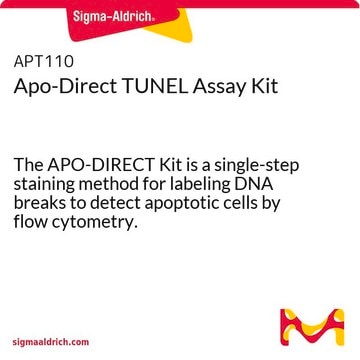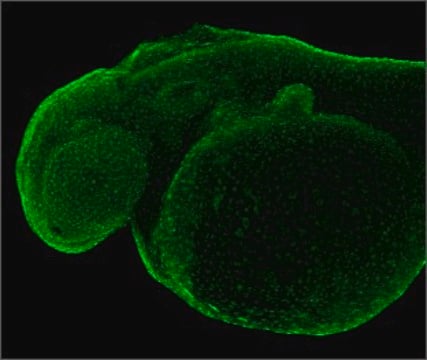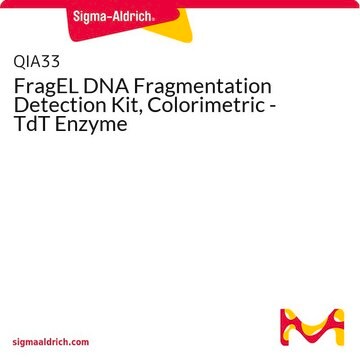11772457001
Roche
TUNEL AP
sufficient for 70 tests, solution, pkg of 3.5 mL
Autenticatiper visualizzare i prezzi riservati alla tua organizzazione & contrattuali
About This Item
Codice UNSPSC:
41105600
Prodotti consigliati
Stato
solution
impiego
sufficient for 70 tests
Confezionamento
pkg of 3.5 mL
Produttore/marchio commerciale
Roche
Condizioni di spedizione
wet ice
Temperatura di conservazione
2-8°C
Descrizione generale
TUNEL AP is an alkaline phosphatase-labeled antibody used for the in situ detection of apoptosis (programmed cell death) with the TUNEL reaction followed by transmission light microscopy.
The tailing reaction using TdT, also named ISEL (in situ end labeling) or TUNEL (TdT-mediated dUTP nick end labeling), has several advantages in comparison to the in situ nick translation (ISNT) using DNA polymerase:
- Label intensity of apoptotic cells is higher with TUNEL compared to ISNT, resulting in an increased sensitivity.
- Kinetics of nucleotide incorporation is very rapid with TUNEL compared to the ISNT.
- TUNEL preferentially labels apoptotic cells compared to necrotic cells.
Applicazioni
TUNEL AP is an antibody that is used to convert fluorescence-based TUNEL assays into colorimetric assays suited for light microscopy. The conversion is performed by binding of an anti-fluorescein antibody to FITC-dUTP. The antibody is labeled with alkaline phosphatase (AP). The AP is visualized with a precipitating substrate, such as Fast Red or NBT/BCIP.
Componenti
Anti-fluorescein antibody, Fab fragment from sheep, conjugated with alkaline phosphatase (AP). Ready-to-use solution.
Altre note
For life science research only. Not for use in diagnostic procedures.
Avvertenze
Warning
Indicazioni di pericolo
Consigli di prudenza
Classi di pericolo
Skin Sens. 1
Codice della classe di stoccaggio
12 - Non Combustible Liquids
Classe di pericolosità dell'acqua (WGK)
WGK 1
Punto d’infiammabilità (°F)
No data available
Punto d’infiammabilità (°C)
No data available
Scegli una delle versioni più recenti:
Possiedi già questo prodotto?
I documenti relativi ai prodotti acquistati recentemente sono disponibili nell’Archivio dei documenti.
I clienti hanno visto anche
Maosheng Xia et al.
Function (Oxford, England), 2(2), zqab003-zqab003 (2021-01-12)
Metal implants are used worldwide, with millions of nails, plates, and fixtures grafted during orthopedic surgeries. Iron is the most common element of these metal implants. As time passes, implants can be corroded and iron can be released. Ionized iron
R Gold et al.
The journal of histochemistry and cytochemistry : official journal of the Histochemistry Society, 41(7), 1023-1030 (1993-07-01)
Since DNA fragmentation is a key feature of programmed cell death (PCD) and also occurs in certain stages of necrosis, we have adapted the methodology of in situ nick-translation (ISNT) to detect DNA fragmentation on a single-cell level. We first
Beina Chen et al.
Communications biology, 5(1), 105-105 (2022-02-05)
Stroke causes degeneration and death of neurones leading to the loss of motor function and frequent occurrence of cognitive impairment and depression. Lithium (Li+), the archetypal mood stabiliser, is neuroprotective in animal models of stroke, albeit underlying mechanisms remain unknown.
Wu Jiang et al.
Clinical and experimental pharmacology & physiology, 49(1), 122-133 (2021-09-09)
Previous studies reveal that hydrogen sulphide (H2 S) exerts neuroprotection against neurotoxin-induced Parkinson's disease (PD), but the underlying mechanism remains elusive. The present study was aimed to investigate whether H2 S inhibits neuronal apoptosis of substantia nigra with the involvement
W Gorczyca et al.
Cytometry, 15(2), 169-175 (1994-02-01)
The predominant mode of either spontaneous or drug-induced death of cells in tumors is apoptosis. A flow cytometric method was developed in our laboratory to identify apoptotic cells, based on labeling DNA strand breaks, which appear as a result of
Il team dei nostri ricercatori vanta grande esperienza in tutte le aree della ricerca quali Life Science, scienza dei materiali, sintesi chimica, cromatografia, discipline analitiche, ecc..
Contatta l'Assistenza Tecnica.











